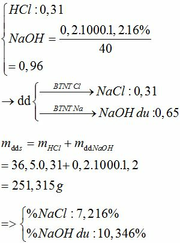Nhiệt phân hoàn toàn 7,26 gam muối nitrat của kim loại R hóa trị III, sau phản ứng thu được 2,4 gam oxit kim loại và hỗn hợp khí A.
a) Xác định kim loại R.
b) Hấp thụ toàn bộ khí A vào 100 ml H2O thu được dung dịch B. Tính pH của dung dịch B ?
Hãy nhập câu hỏi của bạn vào đây, nếu là tài khoản VIP, bạn sẽ được ưu tiên trả lời.

Đặt CT muối \(RCO_3\)
\(RCO_3\rightarrow\left(t^o\right)RO+CO_2\) (1)
\(n_{Ba\left(OH\right)_2}=15.0,01=0,15\left(mol\right)\)
\(n_{BaCO_3}=\dfrac{19,7}{197}=0,1\left(mol\right)\)
`@`TH1: Chỉ tạo ra kết tủa
\(Ba\left(OH\right)_2+CO_2\rightarrow BaCO_3\downarrow+H_2O\)
0,1 0,1 0,1 ( mol )
Theo ptr (1) \(n_{RCO_3}=n_{CO_2}=0,1\left(mol\right)\)
\(M_{RCO_3}=\dfrac{20}{0,1}=200\) \((g/mol)\)
\(\Leftrightarrow R=140\) \((g/mol)\) (loại )
`@`TH2: Tạo ra 2 muối
\(Ba\left(OH\right)_2+CO_2\rightarrow BaCO_3\downarrow+H_2O\)
0,15 ( mol )
0,1 0,1 0,1 ( mol )
\(Ba\left(OH\right)_2+2CO_2\rightarrow Ba\left(HCO_3\right)_2\)
0,05 0,1 ( mol )
Theo ptr (1): \(n_{RCO_3}=n_{RO}=0,1+0,1=0,2\left(mol\right)\)
\(M_{RCO_3}=\dfrac{20}{0,2}=100\) \((g/mol)\)
\(\Leftrightarrow R=40\) \((g/mol)\) `->` R là Canxi ( Ca )
\(m_{CaO}=0,2\left(40+16\right)=11,2\left(g\right)\)


Đồng nhất dữ kiện để thuận lợi cho tính toán, bằng cách nhân đôi khối lượng H2O.
a.
BTNT H: nH2 = nH2O = 0,31 mol
=> nHCl = 0,62mol
BTKL: m kim loại + mHCl = mA + mB => 12,6 + 36,5 . 0,62 = m + 2 . 0,31 => m = 34,61g
b.



Đặt CT oxit kim loại là \(R_2O_n\)
\(R_2O_n+nCO\rightarrow\left(t^o\right)2R+nCO_2\) (1)
\(\overline{M_X}=19.2=38\) \((g/mol)\)
\(\Leftrightarrow\dfrac{28n_{CO\left(dư\right)}+44n_{CO_2}}{n_{CO\left(dư\right)}+n_{CO_2}}=38\)
\(\Leftrightarrow10n_{CO\left(dư\right)}-6n_{CO_2}=0\) (1)
\(n_{Ca\left(OH\right)_2}=2,5.0,025=0,0625\left(mol\right)\)
\(n_{CaCO_3}=\dfrac{5}{100}=0,05\left(mol\right)\)
`@` TH1: chỉ tạo ra kết tủa
\(Ca\left(OH\right)_2+CO_2\rightarrow CaCO_3\downarrow+H_2O\)
0,05 0,05 0,05 ( mol )
\(n_{CO_2}=0,05\) theo ptr (1)\(\Rightarrow n_{R_2O_n}=\dfrac{0,05}{n}\left(mol\right)\)
\(M_{R_2O_n}=\dfrac{4}{\dfrac{0,05}{n}}=80n\) \((g/mol)\)
\(\Leftrightarrow2R+16n=80n\)
\(\Leftrightarrow R=32n\)
`n=2->R` là Cu `->` CT oxit: \(CuO\)
`@`TH2: Ca(OH)2 hết
\(Ca\left(OH\right)_2+CO_2\rightarrow CaCO_3\downarrow+H_2O\)
0,0625 ( mol )
0,05 0,05 0,05 ( mol )
\(Ca\left(OH\right)_2+2CO_2\rightarrow Ca\left(HCO_3\right)_2\)
0,0125 0,025 ( mol )
\(n_{CO_2}=0,05+0,025=0,075\left(mol\right)\)
Theo ptr (1) \(n_{R_2O_n}=\dfrac{0,075}{n}\left(mol\right)\)
\(M_{R_2O_n}=\dfrac{4}{\dfrac{0,075}{n}}=\dfrac{160}{3}n\)
\(\Leftrightarrow2R+16n=\dfrac{160}{3}n\)
\(\Leftrightarrow R=\dfrac{56}{3}n\)
`n=3->R` Fe `->` CT oxit: \(Fe_2O_3\)